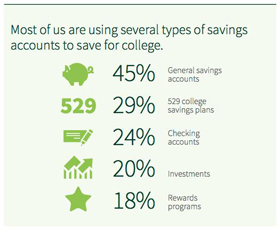Saving for College: What are your options?
In the next few weeks, high school seniors from all across the country will be anxiously checking their mailboxes and e-mail inboxes for acceptance letters from their top choice college or university. It’s an exciting time in their life and a time that their families have, hopefully, been saving towards for several years.
Sallie Mae’s How America Saves for College report details how much money families are saving for college and the strategies they are using to save. In 2014, 51% of families with children under 18 were saving for college (up from 50% in 2013, but still down from the highest report of 62% in 2009) and they have saved an average of $15,346 (up 30% from 2013).
In 2014, almost 75% of families were using traditional savings accounts or 529 college savings plans to grow their college spending dollars. Additionally, families are using checking accounts, investments and reward programs (such as Upromise).
Savings or Deposit Accounts
 Your credit union or banking institution offers a variety of accounts that you can use to kick-start your child’s college savings. Think about opening a “club” account that you can fund automatically through payroll deduction or direct deposit. Or take things up a notch and open an interest-earning share certificate account which has higher return rates and terms up to 10 years (referred to as Certificates of Deposit or CDs at banks).
Your credit union or banking institution offers a variety of accounts that you can use to kick-start your child’s college savings. Think about opening a “club” account that you can fund automatically through payroll deduction or direct deposit. Or take things up a notch and open an interest-earning share certificate account which has higher return rates and terms up to 10 years (referred to as Certificates of Deposit or CDs at banks).
If your child is still in the newborn-phase, a general rule of thumb is to save $250-$500 per month, depending on your plans for an in-state public school, out-of-state school or private university. If you started saving for college a little later, then you’ll want to consider increasing these amounts, however you are able.
529 Savings Plans*
These are college savings and investment plans that are offered by each state. The beauty of the 529 college saving plan is the tax benefits. The funds that you save in a 529 plan grow tax-deferred. Additionally, distributions are free of federal taxes, as well as state taxes in 34 states, as long as they are used for higher education purposes. Otherwise, you may be assessed a 10% fee to withdraw your money.
Additionally, 529 plans are transferable. So if one child doesn’t pursue higher education or doesn’t need all the funds in their account, it can be handed down to a sibling.
No matter which strategy your family uses to save for college, here are a few tips to make the most of your college savings:
Rule of Thirds: Don’t panic! You don’t necessarily need to have four years of total tuition saved by the time your child is sending out college applications. Focus on the Rule of Thirds, which recommends having one-third of tuition costs in savings, one-third of costs coming from your current income (which includes grants, scholarship and other aid that doesn’t require repayment), and the final one-third from loans.
Don’t Prioritize College Over Retirement: College is expensive and only growing more expensive, but you should never prioritize saving for college above saving for your retirement. There are far more opportunities available for funding your child’s schooling than there are for funding your future. An additional benefit to growing your 401K or IRA is that financial aid formulas do not recognize your retirement savings as an available asset for tuition payment.
Keep Savings in Your Name: Financial aid formulas that assess a family’s need are based 20% on assets in the child’s name and only 5.6% on assets in the parents’ names. So it’s best to keep savings in your accounts until it is time to write that tuition check.

